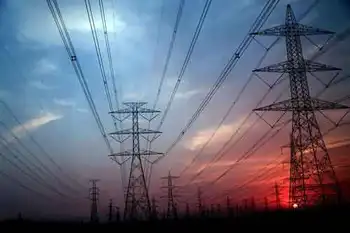Copper thefts rising across nation
By McClatchy Tribune News
Electrical Testing & Commissioning of Power Systems
Our customized live online or in‑person group training can be delivered to your staff at your location.

- Live Online
- 12 hours Instructor-led
- Group Training Available
"It blows my mind, it really does," remarked Duke Energy spokesman Rick Burger, acknowledging the cutting of copper ground wires from utility poles throughout the Wabash Valley, as well as the theft of hanging lines from poles. "I know times are hard right now, but I can't believe the risk they're putting themselves in," he said.
Burger added that thefts at substations have occurred, noting that log chains and trucks were used to rip off the security gates of one recently. "Hey, one volt will kill you the same as 1,000 volts," he said, adding that live wires running from the utility poles being stripped carry 7,200 volts, and the danger involved is immense.
And Terre Haute City Council President Todd Nation, D-4th, has been hearing all about it from local contractors, homeowners and even experienced it himself firsthand. Nation was remodeling one of his properties on Wabash Avenue and had carried "hundreds of pounds" of 50-year old copper wire into the alley to get ready to haul off to a scrap yard.
But in between the third load and a short dinner break, someone made off with the first three large rolled piles that had been secured in a closed alley behind his building. "It was hundreds of pounds," he said, noting kids could not possibly have just picked it up and ran down the street.
"That really opened my eyes."
But it wasn't just the copper wiring at his building. Over time, Nation has had plumbing, HVAC supplies as well as a historic brass plaque stolen from his property.
"This is a widespread national problem. This is not just a Terre Haute thing," he said, noting local police are doing their best but that he's open to more direct community involvement in the matter.
For Mayor Duke Bennett, it's a sign of the times.
"We're aware of it," he said. "It's been ongoing for some time. It just seems to be more prevalent and people are becoming more brazen."
Nation offered concurring thoughts, telling of his walk up and down the alleys behind Farrington Grove and seeing nearly every copper ground wire cut from the utility poles.
Both have been in contact with Burger about the dangers of ungrounded lines and hanging wires. But in the end, Bennett said it all comes down to a tough economy.
"I think there are a lot of people out there in bad financial situations and they're out there trying to supplement that. And then there are some people out there trying to feed a drug habit," he said. And the driving force behind what Bennett called a "growing epidemic" and Nation described as a "free-for-all atmosphere" is the high number of vacant and condemned houses in the area.
Bennett guesstimated about 200 vacant homes on the condemnation list at present, and described their status as "a no man's land" while going through the process.
"They're not really anybody's responsibility while they're going through the court system," he said, noting that no one is there to report a theft. According to Nation, it's going to take a community effort.
"We all need to be paying more attention to whether those properties are locked, boarded or allowed to stand open," he said, calling the number of condemned houses a "moving pool" in that more home on line every day.
"This is linked directly to vacant or abandoned homes," he said, describing an "atmosphere" where these kind of crimes can thrive. "It's just amazing. These people are getting really brazen," Bennett noted.
And for some, the first finger pointed might go toward scrap dealers who buy the materials. But as Tom Haley, general manager of Goodman & Wolfe's 1350 College Ave. plant said, recyclers already try to keep tabs on the sellers.
Individuals bringing copper or other materials to the plant are required to show identification and those records are kept, tracked and if needed, provided to law enforcement.
"The vast majority of our customers, and I'm saying 99 percent, are good, honest citizens just doing their recycling," Haley said. "It's that one percent out there doing bad stuff that gives the industry a black eye."
Goodman & Wolfe, along with much of the industry, supported Indiana House Bill 1324 that went into effect in July 2007 and gives recyclers a mandated reason to require the tracking of the materials.
And as hard hit as citizens might be by the bad economy, when it comes to prices paid for copper, steel and other building materials, the market is booming. "They've been at record amounts," Haley said of the prices, noting that depending on the quality, copper wiring can bring anywhere from $1.30 to more than $3 per pound. "The last few months have been record months."
Ruined appliances from recently flooded homes have been coming into his plant at high volume, and Haley estimated a 200-pound stove would bring about $14 when brought there. And Burger himself said he doesn't blame the local recyclers, with whom he said Duke Energy has a good relationship.
"These (copper thieves) are getting smart," Burger said. "They're taking it way, way out now," and Duke Energy has recovered material stolen from Terre Haute as far away as Ohio. But Nation said he's up for looking around for solutions to a problem that doesn't seem to be getting any better.
"I think that we need to look at what other communities are doing," he said in reference to Indianapolis and others. "We need to get a handle on it."
Bennett agreed that more needs to be done and said discussions are under way about specific proposals, but declined to mention those until they're more solidified.
In the meantime, it's a matter of safety and money.
"I'm surprised someone hasn't gotten zapped yet," Nation said, echoing comments by all involved. Burger said any time people see downed or hanging wires, they should assume they're live and call in a report. "Some of those are hot," he said.
And when it comes to the cost of repairs, "I'd just say the sky's the limit," Burger said, adding up the cost of materials, time and labor. "Easily several thousands of dollars... And who pays for that? The paying customers."
The "ground wires," he explained, ground each pole the same way an electrical box inside a home is grounded.
Cutting those wires from poles shifts more energy onto the other grounds, and can in fact cause surges in transformers and leave them vulnerable to lightning. Duke Energy doesn't know the poles are damaged unless someone calls them, or until it's too late, he said.
"It really does create a lot of problems for us as an electrical energy company," he said.
And a potential liability for all involved. "Someone's going to make a mistake and they're going to end up dead," Bennett said.











